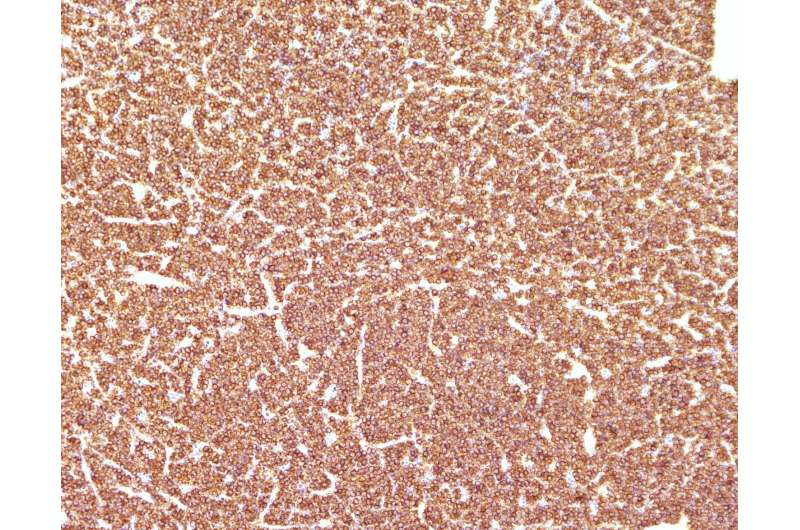'Capicua' gene plays a key role in T-cell acute lymphoblastic leukaemia

Researchers at the Spanish National Cancer Research Centre (CNIO) have discovered a genetic alteration that is directly involved in at least 10 percent of cases of a common cancer in children, T-cell acute lymphoblastic leukaemia. In a paper published this week in the printed edition of Genes and Development, the scientists explain that if a specific gene called Capicua is inactivated, test mice inevitably develop this type of leukaemia.
They have also discovered that MEK protein inhibitors such as the drug trametinib, which are already being used to treat some tumours, no longer work. The researchers hope to determine why these treatments are not effective in certain patients. The study has been co-directed by Mathias Drosten, and Lucía Simón-Carrasco is the lead author.
The vast majority of tumours are caused by mutations in various genes. Knowing each and every one of the genetic factors involved in cancer is essential in order to discover the individual features of each tumour. This is the only way to develop more effective personalised therapies. Therefore, identifying a gene that plays a key role in 10 percent of the cases of a certain type of cancer—a fairly high incidence—is relevant. "Especially taking into account that inactivating Capicua is enough to trigger the appearance of T-cell tumours, at least in mice," says Drosten.
Capicua is a component of a cancer highway
The CNIO researchers focused on Capicua while decoding one of the most important biochemical signal highways for cells, the so-called RAS-MAPK pathway. Scientists from all over the world have been studying this pathway for decades to understand how the signals are transmitted from molecule to molecule, and why, if there are any failures, cancer often develops.
As Drosten explains, it has been found that RAS-MAPK has a first section that is "quite linear," in which each signal activates the next one, but at some point, the trunk branches out and a tree of signals appears. More than a hundred genes are known to play a role in this stage, and Capicua is one of them.
The CNIO Group focused their attention on this gene because it frequently appears mutated into different types of cancer. It was originally discovered in fruit flies. The name refers to the Catalonian word in "cap-i-cua" (head and tail), since the heads of the embryos of the fly with the mutated gene are directly connected to their tails. The function of this gene in mammals, where it is usually called CIC, is not well known.
Simon-Carrasco and his colleagues developed a mouse model at the CNIO to study what happens when they inactivate CIC/Capicua. The most striking result was the development of T-cell acute lymphoblastic leukaemia (T-ALL) in the animals. This is the first time it has been found that the inactivation of Capicua in adult mice leads to the formation of T-ALL tumours.
To verify the relevance in humans of this result, the researchers analysed T-ALL tumour samples, and found that the Capicua gene appears mutated in at least 10 percent of them. Given that the inactivation of Capicua is what generated acute lymphoblastic leukaemia, this gene acts as a tumour suppressor. The pattern of mutations previously observed in cancers in which Capicua appears mutated already pointed to this function, but this is the first time that the hypothesis has been confirmed experimentally. Knowing that Capicua is a tumour suppressor provides many clues to understanding what it does in other tumours.
Resistance inductor
One of the findings of the paper may also have therapeutic relevance in the short term. The researchers have discovered that the tumours in which Capicua appears inactivated do not respond to drugs that act via the RAS-MAPK pathway. It seems to work as a resistance system—the drugs act as the brake pedal, but there is no effect if the brake pads (Capicua) are damaged.
"Many tumours are treated with drugs that affect the RAS-MAPK pathway; therefore, if we know that Capicua is involved in their level of effectiveness, we will know which patients are more likely to develop resistance to these treatments," says Lucia Simón-Carrasco.
The study also provides clues about the relationship between Capicua and the formation of tumours. Capicua directly represses the ETV4 gene, which has oncogenic potential; when Capicua is inactivated, the expression of ETV4 increases. When the researchers removed the functions of Capicua and ETV4 simultaneously, they noted an almost complete inhibition regarding the formation of T-ALL tumours.
"This is the first direct evidence available about the way in which the inactivation of CIC causes the formation of tumours," says Simón-Carrasco.
"A better understanding of the molecular events triggered by the inactivation of Capicua should provide more effective therapeutic approaches," the researchers conclude in their paper.
More information: Lucía Simón-Carrasco et al, Inactivation of Capicua in adult mice causes T-cell lymphoblastic lymphoma, Genes & Development (2017). DOI: 10.1101/gad.300244.117

















